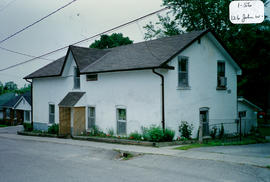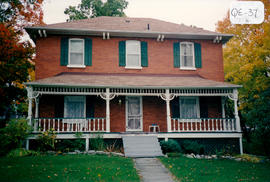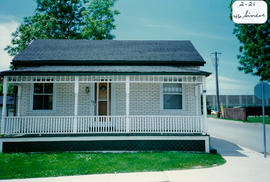- CA BWGPL GJ-HB-2017-04-06-04
- Stuk
- 1996
Part of George Jackson fonds
The mid-block building located on the south side at 126 John St. West was built in the 1880’s in the Gothic Revival Cottage style. Originally, there was a back lane for Jim Woods' house and barn next to this house. Pratt lived here many years ago with his wife and two sons. Elgar Houghton bought this house around the time of World War II. He lived there for a time and then he had the house converted into four apartments which were rented. He later sold the building.
The 1½-storey, five-bay cottage has a rectangular plan with a centre hall, an asymmetrical façade with an off-centre gable over the entrance, and a medium-pitched, gable roof. There is a simple, rectangular entrance (at grade level) with windows to the primary rooms on each side. The existing roof over the entry is not original. Small windows at the ground and second floors are not original. They are set into segmented, arch openings with plain, wood frames and painted, stone lug sills. Brick, masonry construction is clad with stucco (not original) and the structure has a parged, stone foundation. According to the 2000 inventory, this modest house has few original details other than the building’s form. (1, 2, 3)
Zonder titel




